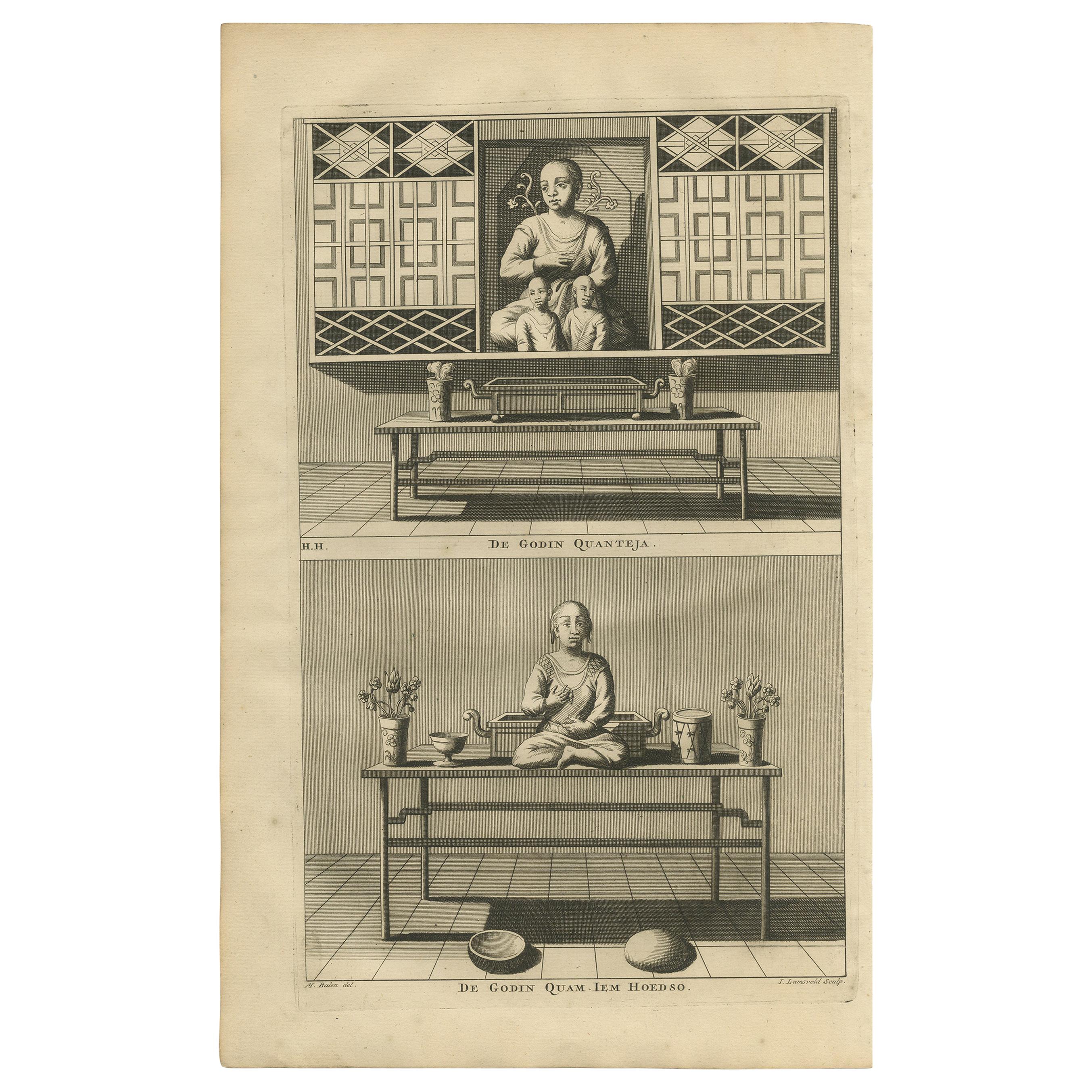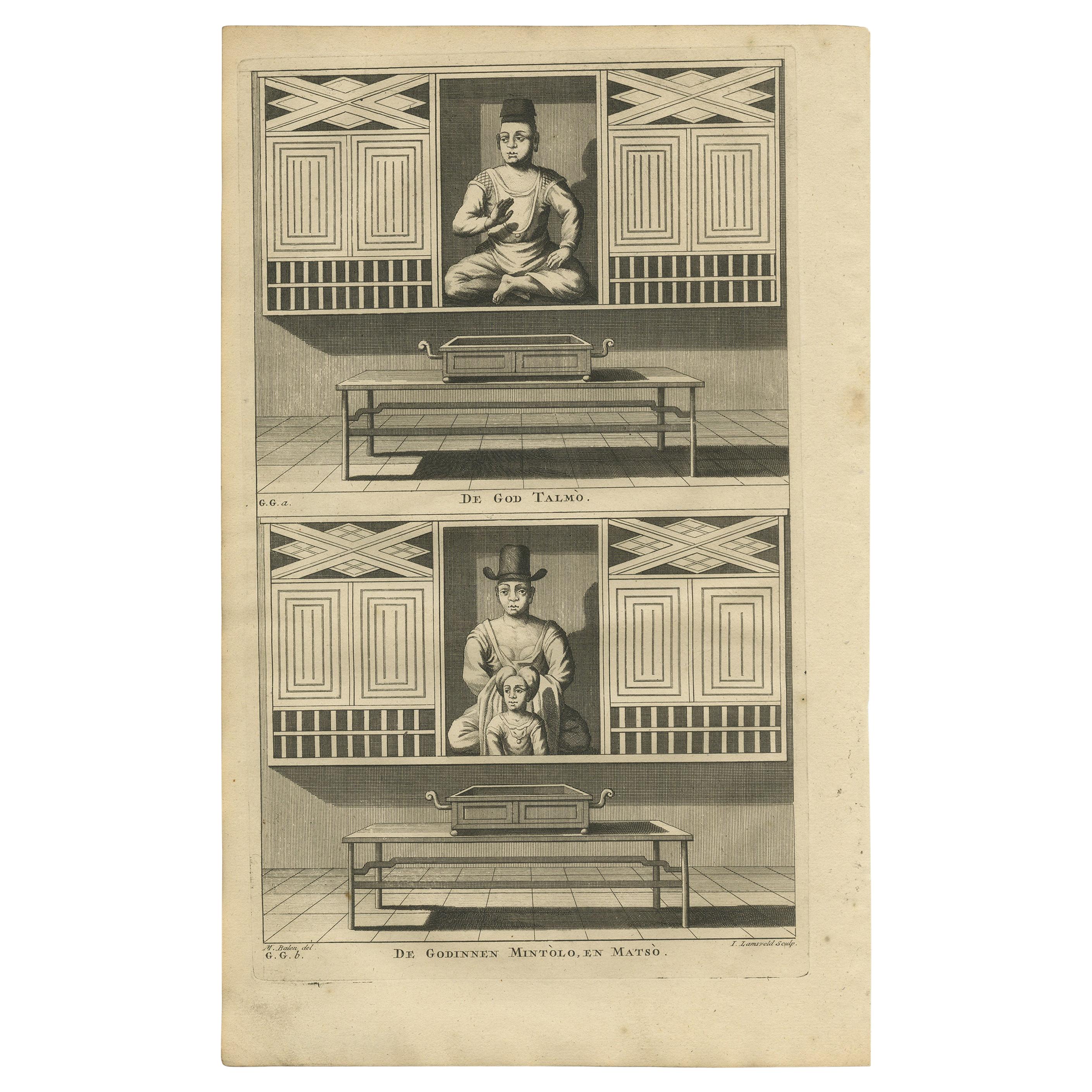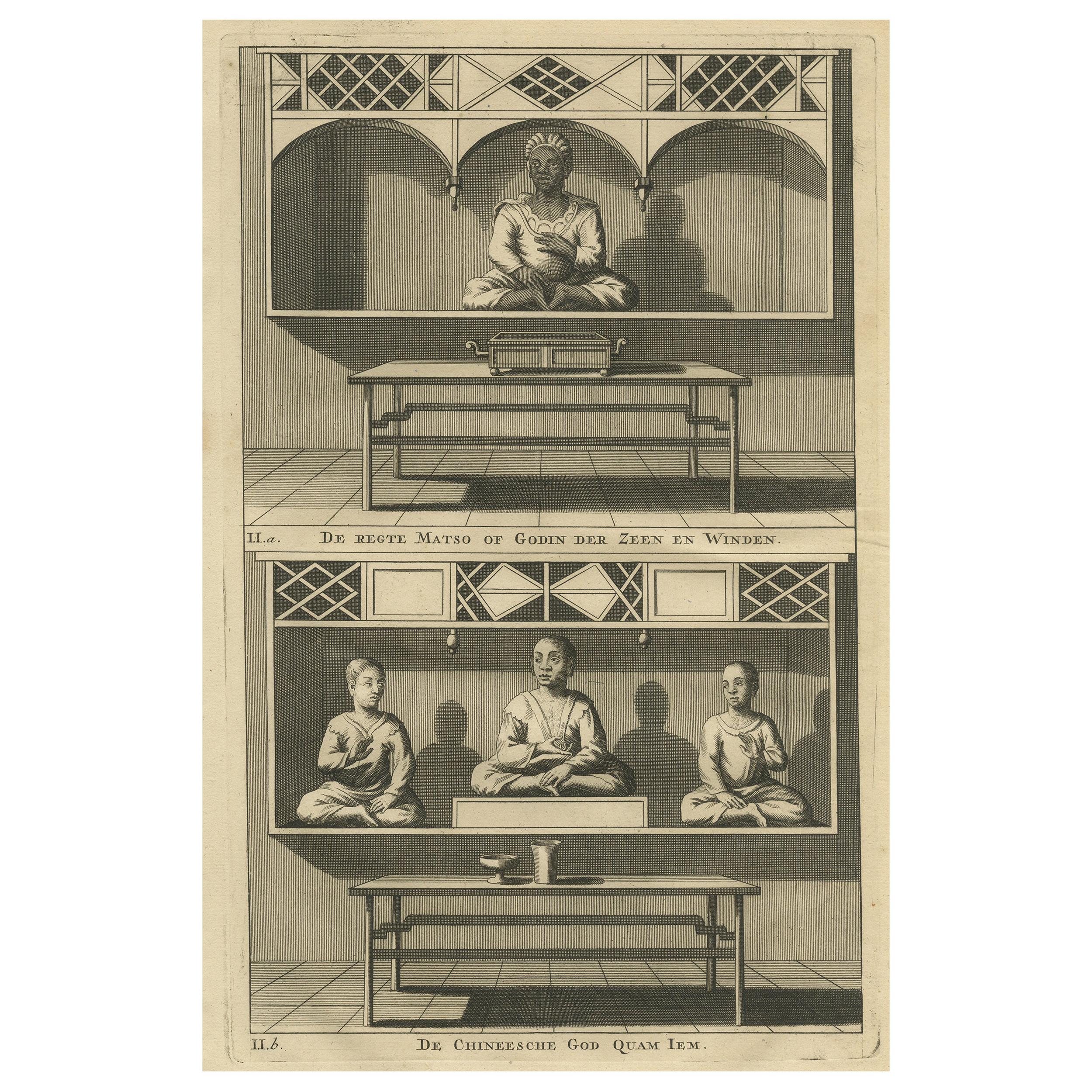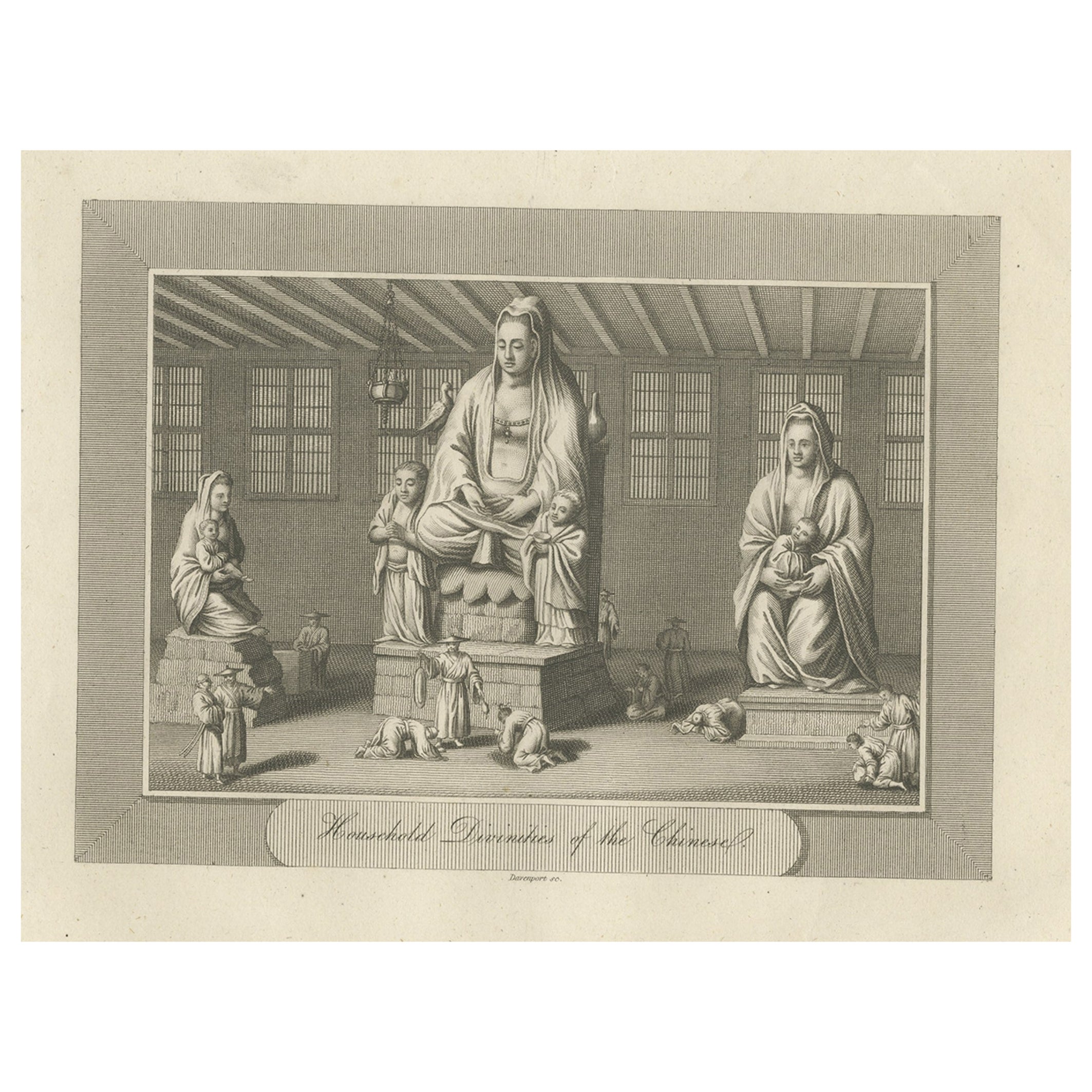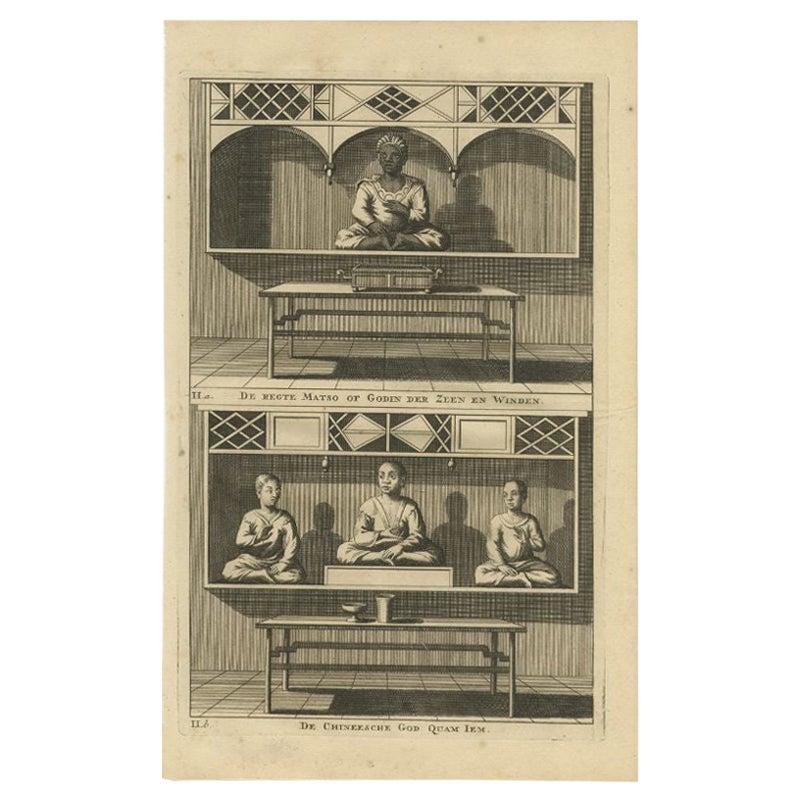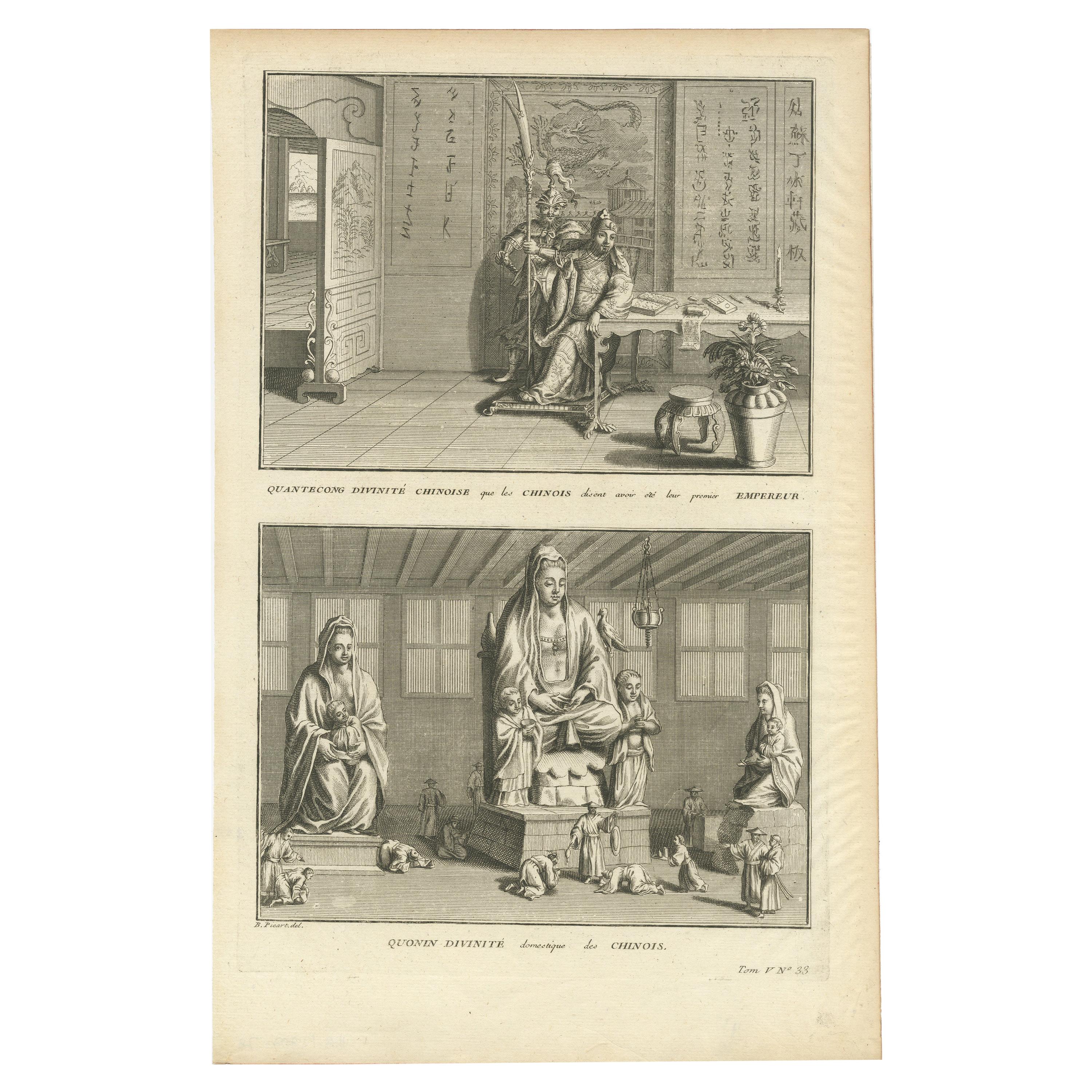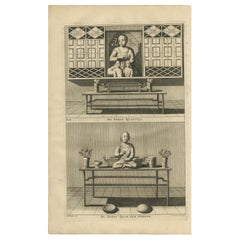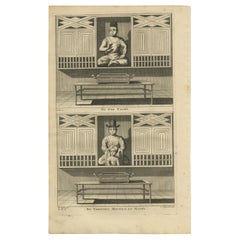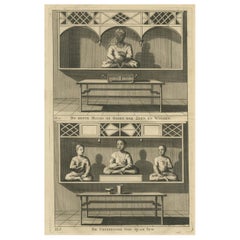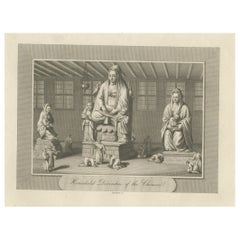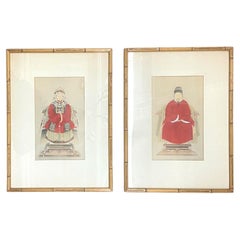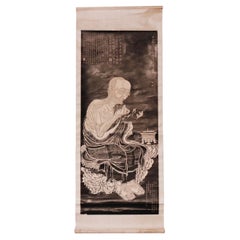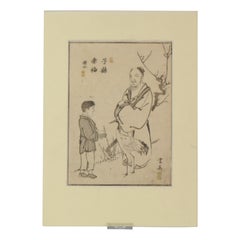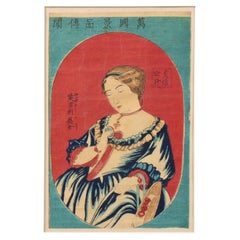Items Similar to Old Print of Female Deities of Chinese Buddhism, Quanteja and Quam Iem Hoedso
Want more images or videos?
Request additional images or videos from the seller
1 of 6
Old Print of Female Deities of Chinese Buddhism, Quanteja and Quam Iem Hoedso
$245.74
$307.1820% Off
£184.20
£230.2520% Off
€208
€26020% Off
CA$337.61
CA$422.0120% Off
A$376.91
A$471.1320% Off
CHF 197.49
CHF 246.8720% Off
MX$4,613.72
MX$5,767.1520% Off
NOK 2,508.17
NOK 3,135.2220% Off
SEK 2,364.89
SEK 2,956.1120% Off
DKK 1,583.37
DKK 1,979.2120% Off
About the Item
Antique print titled 'Intrede des Chineschen Tempels - De Chineesche God Calamija'. Copper engraving of two female deities of Chinese Buddhism in Indonesia; Quanteja and Quam Iem Hoedso. This print originates from 'Oud en Nieuw Oost-Indiën' by F. Valentijn.
Artists and Engravers: François Valentijn (1666-1727), a missionary, worked at Amboina from 1684 to 1694 and 1705 to 1713 and travelled extensively in the VOC's lands.
Condition: Good, general age-related toning. Minor wear and creasing. Please study image carefully.
Date: 1726
Overall size: 20 x 33 cm.
Image size: 17.5 x 28 cm.
Antique prints have long been appreciated for both their aesthetic and investment value. They were the product of engraved, etched or lithographed plates. These plates were handmade out of wood or metal, which required an incredible level of skill, patience and craftsmanship. Whether you have a house with Victorian furniture or more contemporary decor an old engraving can enhance your living space. We offer a wide range of authentic antique prints for any budget.
- Dimensions:Height: 13 in (33 cm)Width: 7.88 in (20 cm)Depth: 0 in (0.01 mm)
- Materials and Techniques:
- Period:
- Date of Manufacture:1726
- Condition:Condition: Good, general age-related toning. Minor wear and creasing. Please study image carefully.
- Seller Location:Langweer, NL
- Reference Number:Seller: JAK-3011stDibs: LU3054329684752
About the Seller
5.0
Recognized Seller
These prestigious sellers are industry leaders and represent the highest echelon for item quality and design.
Platinum Seller
Premium sellers with a 4.7+ rating and 24-hour response times
Established in 2009
1stDibs seller since 2017
2,513 sales on 1stDibs
Typical response time: <1 hour
- ShippingRetrieving quote...Shipping from: Langweer, Netherlands
- Return Policy
Authenticity Guarantee
In the unlikely event there’s an issue with an item’s authenticity, contact us within 1 year for a full refund. DetailsMoney-Back Guarantee
If your item is not as described, is damaged in transit, or does not arrive, contact us within 7 days for a full refund. Details24-Hour Cancellation
You have a 24-hour grace period in which to reconsider your purchase, with no questions asked.Vetted Professional Sellers
Our world-class sellers must adhere to strict standards for service and quality, maintaining the integrity of our listings.Price-Match Guarantee
If you find that a seller listed the same item for a lower price elsewhere, we’ll match it.Trusted Global Delivery
Our best-in-class carrier network provides specialized shipping options worldwide, including custom delivery.More From This Seller
View AllAntique Print of Female Deities of Chinese Buddhism by Valentijn, 1726
Located in Langweer, NL
Antique print titled 'Intrede des Chineschen Tempels - De Chineesche God Calamija'. Copper engraving of two female deities of Chinese Buddhism in Indonesia; Quanteja and Quam Iem Hoe...
Category
Antique Mid-18th Century Prints
Materials
Paper
$94 Sale Price
20% Off
Antique Print of Deities of Chinese Buddhism by Valentijn, 1726
Located in Langweer, NL
Antique print titled 'De God Talmo - De Godinnen Mintolo en Matso'. Copper engraving of a god and two female deities of Chinese Buddhism in Indonesia; Talmo and Mintolo, Matso/Mazu. ...
Category
Antique Mid-18th Century Prints
Materials
Paper
$94 Sale Price
20% Off
Antique Print of a Chinese Temple and Chinese Deity Calamija by Valentijn, 1726
Located in Langweer, NL
Antique print titled 'De regte Matso of Godin der Zeen en Winden - De Chineesche God Quam Iem'. Copper engraving of Mazu, also known as Matsu, a popular Taoist and Chinese Buddhist goddess. Below the Chinese God...
Category
Antique Mid-18th Century Prints
Materials
Paper
$94 Sale Price
20% Off
Antique Engraving of Chinese Deities, 1808
Located in Langweer, NL
Antique print titled 'Household Divinities of the Chinese'.
Engraving of a Chinese deities. This print originates from 'The World: or the Present State...
Category
Antique Early 1800s Prints
Materials
Paper
$236 Sale Price
42% Off
Antique Print of a Chinese Temple and Chinese deity Calamija by Valentijn, 1726
Located in Langweer, NL
Antique print titled 'De regte Matso of Godin der Zeen en Winden - De Chineesche God Quam Iem'. Copper engraving of Mazu, also known as Matsu, a popular Taoist and Chinese Buddhist g...
Category
Antique 18th Century Prints
Materials
Paper
$311 Sale Price
20% Off
Antique Print of Chinese Gods by Picart, 'c.1740'
Located in Langweer, NL
Antique print titled 'Quantecong divinité Chinoise (..) - Quonin divinité domestique des Chinois'. Original antique print with two images of Chinese gods....
Category
Antique Mid-18th Century Prints
Materials
Paper
$141 Sale Price
20% Off
You May Also Like
Chinese Export, Ink & Graphite, Vintage Chinese Wall Decorations, Bamboo, 1930s
Located in Manhasset, NY
Chinese Export, Ink & Graphite, Vintage Chinese Wall Decorations, Bamboo, 1930s
Pair of Chinese Export prints or wall decorations featuring an emperor and empress in red robes; desi...
Category
Early 20th Century Decorative Art
Materials
Paper
Antique Chinese Printed Ink Rubbing of Panthaka Arhat, (scroll mounted)
Located in Point Richmond, CA
Chinese ink rubbing printing depicting Panthaka Arhat, no.4 of the 16 arhat images immortalized in stone at the former stupa at Shengyin Temple. Depicted here sitting on a rock with a book in his left hand and snapping his fingers in his right hand, symbolic of the speed at which he obtained enlightenment, accompanied by a beggar’s bowl and an incense burner, complete with colophons and silk scroll mounting. The Emperor Qianlong ordered the stone stele to be carved in 1764 after the arhat designs painted by the famed artist Guanxiu (832-912). Even though the temple was destroyed in the Taiping rebellion, the steles remain and have been reinstalled at the Hangzhou Stele Forest. Condition: Creases from rolling, otherwise fine condition. Mounting: 58” x 22”. 19th Century. Ex Collection: Frank “Till” & Peggy Durdin, San Diego.
For other rubbings of this stele see:
Penn Museum, object number 2010-26-4
The Metropolitan Museum of Art AN#: 59.195.15
Fine Arts Library of Harvard University, record id: W280021_urn-3:FHCL:478850
For another example of this image rendered in jade and lacquer see: “Screen Paintings of Guanxiu’s Sixteen Arhats in the Collection of the Palace Museum” Luo Wehhua translated by Bruce Doar, Orientations, September 2010, p. 104. In this article the image is identified as the sixteenth arhat Abheda, It is explained in this article that Qianlong re-identified the arhats, thus the 16th Arhat attribution for this image. Also in this article the identical colophon by Qianlong above the image is translated as: “These accurate portraits of the Sixteen Arhats were created by the Tang Dynasty painter Guanxiu, as recorded in Xuanhe Huapu (Record of paintings in the Xuanhe Reign), and during the millennium from the Guangming reign period to the present day, the original works were to be found in Zhejiang, where they were housed in the collection of Shengyin Temple in Qiantang (Huangzhou). In spring of the dingchou year (1757) of his reign, the Qianlong emperor undertook a southern tour of inspection and stayed at an imperial lodge on the West Lake. He went to the temple to pay his respects and there he saw the arhats on display and wrote a description of these marvels. The sequence of the arhats and their names had been passed down since ancient times, but they did not correspond to their Sanskrit titles; the sequence of the arhat names conformed instead to the interpretation of the Sanskrit classics by the Zhangjia State Preceptor. The emperor penned the original names and positions in the sequence below each of the figures in accordance with the readings supplied in Tongwen Yuntong (Unified Rhymes), and below each he penned an encomium, which he signed. Then the images were returned to the collection, to be passed down as a perpetual treasure. Now, the fourth great arhat had long gone missing and we did not know where his painting was. But it was merely a trifling matter of matching the images with the names, and now surely we have found him! This I, the emperor, believe.”
All 16 of these rubbings can be found in the Rubel Chinese Rubbings Collection at the Fine Arts Library of Harvard University with the following descriptive historical note: “Rubbing from stele depicting No. 4 of 16 arhats (Lohans, Buddhist saints) -- Nan ti mi duo luo qing you, Panthaka Arhat. Original painting attributed to Guanxiu, 832-912. Inscriptions written by Hongli, Emperor Qianlong (Gaozong, 1711-1799) of Qing Dynasty. 7 seals of Qianlong follow the inscriptions. Script style: in xing shu. Shi liu zun zhe -- "The 16 noble ones" are 16 lohans. Lohans are also called "a-lo-han" based on the transliteration of the Sanskrit term "arhat." (Japanese: Rakan; Chinese: Lohan; Tibetan: Gnas-brtan). Arhats or Arahants are saints or sages said to have renounced nirvana (freedom from the cycle of suffering and rebirth), vowed to remain in the world to protect the Dharma and propagate the Law of the Buddha in order to devote themselves more effectively to the relief of human misery, like the Bodhisattvas. These 16 Arhats, personal disciples distinguished by the Buddha, formed part of the 500 claimed by tradition to have attended the First Council in Rajagrha. The names and abodes of these 16 arhats are given in a work entitled "Record on the Duration of the Law, spoken by the Great arhat Nadimitra," which was translated into Chinese by the famous pilgrim Xuanzang (596-664) in 654. 16 lohans are quite often represented, especially in China and Japan, in sculpture and painting, in poses and with attributes. Every lohan can be easily with special icongraphic characteristics. Guanxiu (Jiang Deyin or Deyuan, a Buddhist monk also named Master Chan Yue, 832-912) -- painter during late Tang to Five Dynasties, specialized in painting lohan figures. Legend has it that the first portraits of the 18 Lohans...
Category
Antique 19th Century Chinese Qing Prints
Materials
Paper
Very Fine Chinese Woodblock Print China Antique, 19th Century
Located in Amsterdam, Noord Holland
Interesting and finely made print
Interesting and finely painted Chinese Silk painting.
Additional information:
Material: Porcelain & Pottery
Type: Paintings, Scrolls & Prints
Regio...
Category
Antique 19th Century Chinese Prints
Materials
Porcelain
$255 Sale Price
20% Off
Antique Japanese Woodblock Print, English Lady, Meiji Period
Located in Amsterdam, Noord Holland
Antique Japanese Woodblock – English Lady – Meiji Period
attributed to Utagawa Kuniteru II
Yokohama-e – Yokohama-e are prints depicting foreigners in Yokohama after Japan was opene...
Category
Antique 19th Century Japanese Meiji Prints
Materials
Paper
Mid-19th Century Chinese Painting on Rice or Pith Paper
Located in Chapel Hill, NC
Mid-19th century Chinese Painting on Rice or Pith Paper. Gouache or opaque watercolor of a student & attendants. Note remarkable details including marble panelled chair...
Category
Antique Mid-19th Century Chinese Qing Paintings and Screens
Materials
Paper
$384 Sale Price
68% Off
Very Fine Antique Chinese Painting Ladies & Calligraphy, Late 19th Early 20th C
Located in Amsterdam, Noord Holland
Interesting and finely painted Chinese Silk painting.
Additional information:
Material: Porcelain & Pottery
Region of Origin: China
Period: 20t...
Category
20th Century Chinese Paintings
Materials
Porcelain
More Ways To Browse
Vintage Fun House
Vintage Glass Boot
Vintage Orrefors Glassware
Vintage Poodle
Vintage Wood Match Box
Walnut Twin Bed
Wendell Black
Westminster Clock
Wild Boar Wood
Wirkkala Leaf
Wooden Carved Monks
Wooden Eagle Sculpture
17th Century Japanned Cabinet
18th Century Waistcoat
18th Century English Pewter
18th Century Tall Case Clock
1920 School Desk
1930s Telephone
